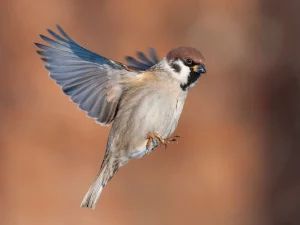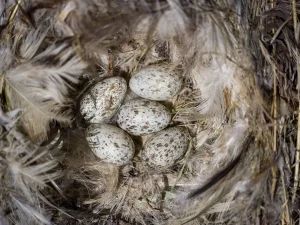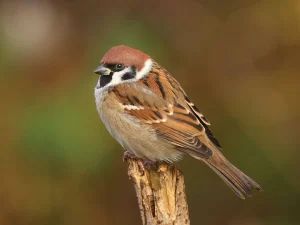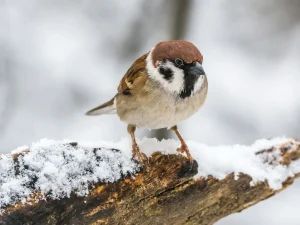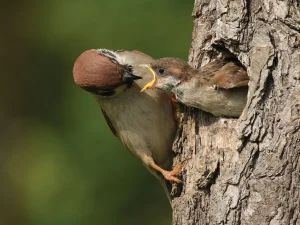Tree Sparrow: a cute and sociable bird with a distinctive chestnut cap and a cheerful chirping call
The Tree Sparrow (Passer montanus) is a delightful little bird known for its adorable appearance, sociable nature, and distinct features. With its chestnut-colored cap and cheerful chirping call, the Tree Sparrow is a charming addition to any bird-watching experience.
Tree Sparrows are small passerine birds, measuring about 12 centimeters in length. They have a compact build with rounded wings and a short, stout beak. One of their most recognizable features is the chestnut-brown cap on their heads, which contrasts beautifully with their grayish-brown upperparts and pale underparts. This cap gives them a distinctive appearance that sets them apart from other sparrow species.
These sparrows are highly sociable birds, often found in flocks and preferring to live and forage together. They thrive in a variety of habitats, including woodlands, farmlands, gardens, and urban areas. Their adaptability and ability to coexist with humans have contributed to their widespread distribution across Europe and Asia.
When it comes to communication, the Tree Sparrow has a cheerful and melodic chirping call. Their songs are a series of high-pitched, tinkling notes that can be heard throughout the day. Their vocalizations are not only a way of expressing themselves but also serve as a means of establishing territory and attracting mates.
Tree Sparrows are primarily seed-eaters, feeding on a variety of seeds, grains, and small fruits. They are often seen foraging on the ground or in low shrubs, searching for food in small flocks. In addition to seeds, they may also consume insects and spiders, especially during the breeding season when they need a protein-rich diet to nourish their young.
During the breeding season, which typically occurs from April to August, Tree Sparrows form monogamous pairs. The male plays an active role in courtship, displaying his vibrant cap and singing to attract a female. Once a pair is formed, they build a cup-shaped nest in tree cavities, crevices, or nest boxes. The female lays a clutch of 4-7 eggs, which are incubated by both parents. After hatching, both parents take part in feeding and caring for the chicks until they fledge and become independent.
The Tree Sparrow’s population has faced some decline in certain regions due to changes in agricultural practices and habitat loss. However, conservation efforts and the provision of nest boxes have helped stabilize their numbers in some areas. Their charming appearance and sociable nature make them a beloved species among bird enthusiasts, and many people take pleasure in providing suitable habitats and food sources to attract these delightful birds to their gardens.
In conclusion, the Tree Sparrow is a captivating bird with its distinctive chestnut cap, sociable behavior, and cheerful chirping call. Its adaptability, preference for living in flocks, and melodic songs add to its appeal. While facing challenges in certain regions, this adorable little sparrow continues to bring joy to bird lovers worldwide with its presence and captivating presence.
Hits: 0
